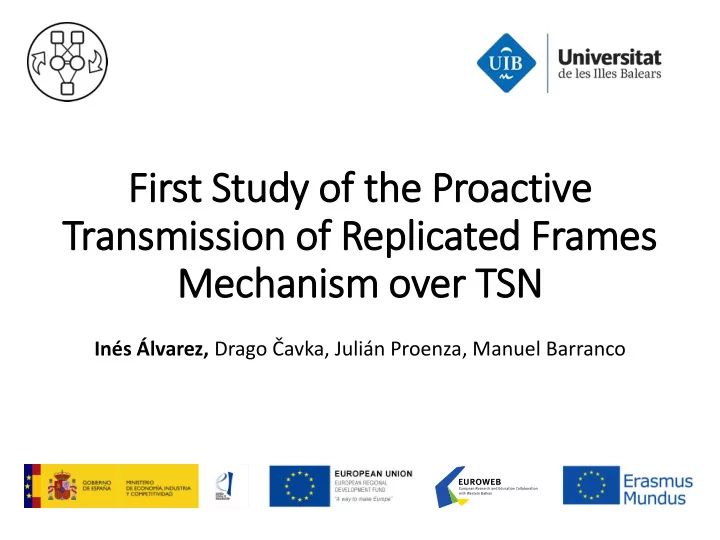

First Study of f the Proactive Transmission of Replicated Frames Mechanism over TSN Inés Álvarez, Drago Čavka , Julián Proenza, Manuel Barranco
2 Introduction • Time-Sensitive Networking (TSN) Task Group. • Developing a set of standards to provide Ethernet: • REAL-TIME GUARANTEES, • ONLINE MANAGEMENT, • RELIABILITY • on the layer 2.
3 Introduction • Time-Sensitive Networking (TSN) Task Group. • Developing a set of standards to provide Ethernet: • REAL-TIME GUARANTEES, • ONLINE MANAGEMENT, • RELIABILITY • on the layer 2.
4 Reliability in TSN • Qci: Per-Stream Filtering and Policing. • Error containment. • Detect babbling idiot. • Detect delayed frames .
5 Reliability in TSN • Qca: Path Control and Reservation • Stablish multiple paths between nodes. • CB: Frame Replication and Elimination for Reliability • Stablish logical links over the created paths. • Send replicated messages through the redundant links .
6 Reliability in TSN • TSN does not have time redundancy on layer 2. • What are the options to tolerate temporary faults?
7 Reliability in TSN • Using spatial redundancy to tolerate temporary faults. • Not a suitable solution: • High cost. • No efficient solutions (specially in highly critical systems).
8 Reliability in TSN • Using ARQ-based protocols. • Not a suitable solution (for HRT systems): • High jitter. • Non-deterministic bandwidth consumption. • ACK/NACK messages introduce new fault scenarios.
9 Reliability in TSN • We propose to use proactive retransmissions. • Lower cost than adding more paths. • Lower jitter than with ARQ. • Deterministic bandwidth consumption. • More efficient than ARQ in the worst case scenario.
10 Proactive Transmission of Replicated Frames End-to-end estimation and replication T B1 B2 L
11 Proactive Transmission of Replicated Frames End-to-end estimation and replication k=3 T B1 B2 L
12 Proactive Transmission of Replicated Frames End-to-end estimation and replication k=3 T B1 B2 L
13 Proactive Transmission of Replicated Frames End-to-end estimation and replication k=3 T B1 B2 L
14 Proactive Transmission of Replicated Frames End-to-end estimation and replication k=3 T B1 B2 L
15 Proactive Transmission of Replicated Frames End-to-end estimation and replication T B1 B2 L
16 Proactive Transmission of Replicated Frames End-to-end estimation, link-based replication T B1 B2 L
17 Proactive Transmission of Replicated Frames End-to-end estimation, link-based replication k'=3 T B1 B2 L
18 Proactive Transmission of Replicated Frames End-to-end estimation, link-based replication k'=3 T B1 B2 L
19 Proactive Transmission of Replicated Frames End-to-end estimation, link-based replication k'=3 T B1 B2 L
20 Proactive Transmission of Replicated Frames End-to-end estimation, link-based replication k'=3 T B1 B2 L
21 Proactive Transmission of Replicated Frames End-to-end estimation, link-based replication T B1 B2 L
22 Proactive Transmission of Replicated Frames Link-based estimation and replication T B1 B2 L
23 Proactive Transmission of Replicated Frames Link-based estimation and replication T B1 B2 L k''=3 k''=2 k''=3
24 Proactive Transmission of Replicated Frames Link-based estimation and replication T B1 B2 L k''=3 k''=2 k''=3
25 Proactive Transmission of Replicated Frames Link-based estimation and replication T B1 B2 L k''=3 k''=2 k''=3
26 Proactive Transmission of Replicated Frames Link-based estimation and replication T B1 B2 L k''=3 k''=2 k''=3
27 Proactive Transmission of Replicated Frames Link-based estimation and replication T B1 B2 L k''=3 k''=2 k''=3
28 IN THIS WORK WE VALIDATE AND COMPARE THE APPROACHES OF THE TIME REDUNDANCY MECHANISM THROUGH SIMULATION
29 OMNeT++ simulation model • Implement the PTRF mechanism over OMNeT++. • TSimNet model as starting point [1]. • Additions: • Creation of replicas. • Identification and elimination of replicas. • Frame structure specification. [1] P. Heise, F. Geyer, and R. Obermaisser. TSimNet: An Industrial Time Sensitive Networking Simulation Framework Based on OMNeT++. In 2016 8th IFIP International Conference on New Technologies, Mobility and Security (NTMS), Nov 2016.
30 OMNeT++ simulation model
31 Experiments • We validated and compared the three approaches. • We used exhaustive fault injection. • Inject all the possible combinations of frame losses. • We used an automotive use case. • Study the behaviour of each approach in a realistic scenario.
Recommend
More recommend